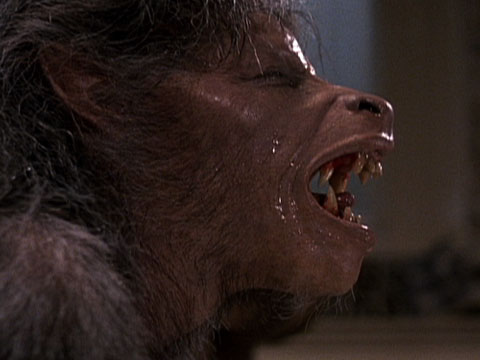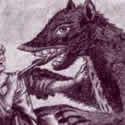Werewolf myths have been around perhaps even longer than those associated with vampires and zombies. For example, Ancient Greek mythology tells of Lycaon, a man transformed into a wolf after eating human flesh. Furthermore, the word
werewolf is thought to be derived from the Old English
wer, meaning "man." While the specific attributes of werewolves vary across different cultures, the beast itself is generally the same: a part-man, part-wolf creature of the night who preys on humans. But just as with vampires and zombies, most of the myths surrounding werewolves do not hold up to scrutiny.
Only silver can kill a werewolf
Source: Silver is identified with the moon and is therefore ideal to slay a creature transformed under the light of the full moon. Eventually this myth expanded to include all "unnatural" creatures of the night, such as vampires.
Fact:
To kill a werewolf, you must use bullets or cartridges with serious stopping power to pierce its thick hide, but they need not be made of silver. Just be sure to aim for the head or the heart.
Werewolves only appear/attack during a full moon
 |
|
Doctor Who |
Source: Long-running superstitions about the full moon's effects on animals and humans. A similar myth depicts werewolf transformation as being triggered by a full moon, or by negative emotions.
Fact:
Werewolves can appear and attack at any time, although they are much more active at night. Furthermore, the moon has no effect on a werewolf's transformation process, nor does its mental state.
A lycanthrope will transform into a werewolf at sunset and revert back to its human form by sunrise or death
Source: Numerous Hollywood movies.
 |
|
An American Werewolf in London |
Fact: The transformation from human to werewolf is both slow and irreversible, taking up to several weeks to complete. Although it makes for good drama, a rapid transformation into a hulking beast is impossible for one important reason: where does all the extra body mass come from? Proteins, fats, sugars, vitamins, water, all the materials required for cellular growth and energy production would have to either be stored in the body in massive amounts or consumed orally as the victim transforms. Even if the person was bloated and obese with stores of extra body mass, transforming within the span of an hour would produce so much cellular heat that it would literally cook the victim to death. Even the 8 to 14-hour transformation into a zombie causes irreversible brain and organ damage from the high heat production.
You can become a werewolf by performing a ritual
Source: Association of werewolves with black magic, Satanism and the occult.
Fact:
You can only become a werewolf by being infected with the lupine parvovirus, which is usually spread from the bite of an infected timber wolf. Infection via a werewolf is actually quite rare, considering the high mortality rate of such encounters.
Werewolves can be avoided by climbing an ash tree or running into a field of rye
Source: The ash tree myth likely stems from Greek mythology, as it was an ash tree that a man of Anthus' family hung his clothes on before swimming across a lake in Arcadia and being transformed into a werewolf. The rye superstition may have come from the fact that rye, commonly eaten by monks, was considered to be a holy grain and therefore able to repel "Satanic" creatures such as werewolves.
Fact:
Because of their long claws and heavy bodies, werewolves make very poor tree climbers. However, they are not bothered by rye (or gluten in general). Even hiding in a tall field of rye wouldn't work, as a werewolf's sharp senses would allow it to find you pretty easily.
Monkshood repels werewolves
Source: Aconitum, aka monkshood or wolfsbane, is one of the most poisonous plants of European origin. Even touching it without gloves can be potentially fatal. Toxins extracted from the plant were historically used to kill wolves, hence the name
wolf's bane. Traditionally, wolfsbane was said to ward off both werewolves and vampires, usually by placing it under one's pillow at night.
Fact:
The only way it would ward off a werewolf is if you buried yourself in an impractically-large pile of it, which is just as hazardous to your health as the beast you're avoiding. Basically, you'd be better off just using bear mace or an air horn.
You can cure yourself by killing the werewolf that bit you
Source: Simply a way to instill courage and false hope in order to get more able-bodied people to hunt werewolves without fear of infection. The same was also applied to vampires, such as the myth that killing the Alpha or "Master" will destroy or cure the entire pack.
Fact:
Once bitten, the only way to avoid turning is death.
Werewolves look identical to common wolves
Source: Similar to vampires and vampire bats, the fact that wolves and werewolves share so many similarities gave rise to the myth that infected wolves were simply another form of werewolf.
Fact:
Werewolves look more like human-wolf hybrids with gigantism.
 |
Lon Chaney, Jr. as The Wolf Man,
source of many werewolf myths |
Werewolves resemble furry humans
Source: Most likely the result of falsely attributing lycanthropy to humans who suffered from hypertrichosis, which causes excessive growth of body and facial hair. Early-stage werewolves look similar to these individuals, although such sightings are extremely rare considering how reclusive they are compared to fully-transformed wolfmen.
Fact:
As stated previously, fully-transformed werewolves barely resemble their original human forms, if at all. In fact, they're often times mistaken as bears.
Werewolves feed on human flesh
 |
|
Bad Moon |
Source: Occasional incidents throughout history, further exacerbated by fear, ignorance and folklore.
Fact:
Like sharks, bears and other predators, werewolves usually dislike the taste of human flesh—preferring instead large wildlife like elk and moose, along with plant materials such as berries and herbs. The attacks that do happen to people are mostly for territorial reasons, although it's not uncommon for werewolves to make opportunistic meals of such kills.
Continue to Werewolves Versus Vampires & Zombies
© 2001-2017 Dango Productions, Inc.













